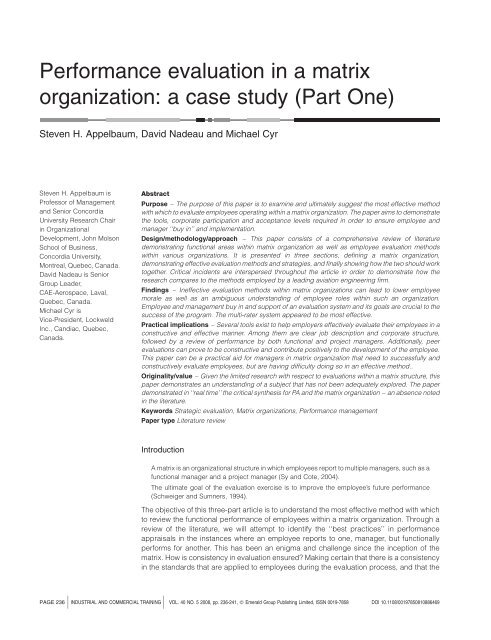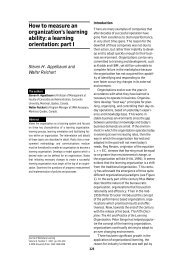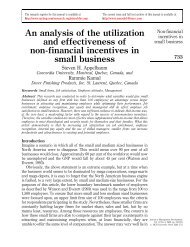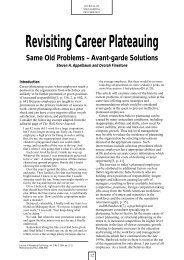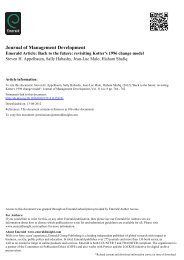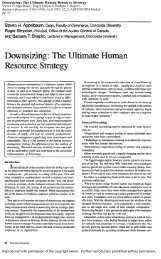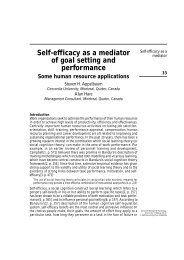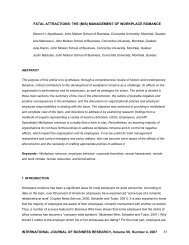Performance evaluation in a matrix organization: a case study (Part ...
Performance evaluation in a matrix organization: a case study (Part ...
Performance evaluation in a matrix organization: a case study (Part ...
- No tags were found...
Create successful ePaper yourself
Turn your PDF publications into a flip-book with our unique Google optimized e-Paper software.
<strong>Performance</strong> <strong>evaluation</strong> <strong>in</strong> a <strong>matrix</strong><strong>organization</strong>: a <strong>case</strong> <strong>study</strong> (<strong>Part</strong> One)Steven H. Appelbaum, David Nadeau and Michael CyrSteven H. Appelbaum isProfessor of Managementand Senior ConcordiaUniversity Research Chair<strong>in</strong> OrganizationalDevelopment, John MolsonSchool of Bus<strong>in</strong>ess,Concordia University,Montreal, Quebec, Canada.David Nadeau is SeniorGroup Leader,CAE-Aerospace, Laval,Quebec, Canada.Michael Cyr isVice-President, LockweldInc., Candiac, Quebec,Canada.AbstractPurpose – The purpose of this paper is to exam<strong>in</strong>e and ultimately suggest the most effective methodwith which to evaluate employees operat<strong>in</strong>g with<strong>in</strong> a <strong>matrix</strong> <strong>organization</strong>. The paper aims to demonstratethe tools, corporate participation and acceptance levels required <strong>in</strong> order to ensure employee andmanager ‘‘buy <strong>in</strong>’’ and implementation.Design/methodology/approach – This paper consists of a comprehensive review of literaturedemonstrat<strong>in</strong>g functional areas with<strong>in</strong> <strong>matrix</strong> <strong>organization</strong> as well as employee <strong>evaluation</strong> methodswith<strong>in</strong> various <strong>organization</strong>s. It is presented <strong>in</strong> three sections, def<strong>in</strong><strong>in</strong>g a <strong>matrix</strong> <strong>organization</strong>,demonstrat<strong>in</strong>g effective <strong>evaluation</strong> methods and strategies, and f<strong>in</strong>ally show<strong>in</strong>g how the two should worktogether. Critical <strong>in</strong>cidents are <strong>in</strong>terspersed throughout the article <strong>in</strong> order to demonstrate how theresearch compares to the methods employed by a lead<strong>in</strong>g aviation eng<strong>in</strong>eer<strong>in</strong>g firm.F<strong>in</strong>d<strong>in</strong>gs – Ineffective <strong>evaluation</strong> methods with<strong>in</strong> <strong>matrix</strong> <strong>organization</strong>s can lead to lower employeemorale as well as an ambiguous understand<strong>in</strong>g of employee roles with<strong>in</strong> such an <strong>organization</strong>.Employee and management buy <strong>in</strong> and support of an <strong>evaluation</strong> system and its goals are crucial to thesuccess of the program. The multi-rater system appeared to be most effective.Practical implications – Several tools exist to help employers effectively evaluate their employees <strong>in</strong> aconstructive and effective manner. Among them are clear job description and corporate structure,followed by a review of performance by both functional and project managers. Additionally, peer<strong>evaluation</strong>s can prove to be constructive and contribute positively to the development of the employee.This paper can be a practical aid for managers <strong>in</strong> <strong>matrix</strong> <strong>organization</strong> that need to successfully andconstructively evaluate employees, but are hav<strong>in</strong>g difficulty do<strong>in</strong>g so <strong>in</strong> an effective method..Orig<strong>in</strong>ality/value – Given the limited research with respect to <strong>evaluation</strong>s with<strong>in</strong> a <strong>matrix</strong> structure, thispaper demonstrates an understand<strong>in</strong>g of a subject that has not been adequately explored. The paperdemonstrated <strong>in</strong> ‘‘real time’’ the critical synthesis for PA and the <strong>matrix</strong> <strong>organization</strong> – an absence noted<strong>in</strong> the literature.Keywords Strategic <strong>evaluation</strong>, Matrix <strong>organization</strong>s, <strong>Performance</strong> managementPaper type Literature reviewIntroductionA <strong>matrix</strong> is an <strong>organization</strong>al structure <strong>in</strong> which employees report to multiple managers, such as afunctional manager and a project manager (Sy and Cote, 2004).The ultimate goal of the <strong>evaluation</strong> exercise is to improve the employee’s future performance(Schweiger and Sumners, 1994).The objective of this three-part article is to understand the most effective method with whichto review the functional performance of employees with<strong>in</strong> a <strong>matrix</strong> <strong>organization</strong>. Through areview of the literature, we will attempt to identify the ‘‘best practices’’ <strong>in</strong> performanceappraisals <strong>in</strong> the <strong>in</strong>stances where an employee reports to one, manager, but functionallyperforms for another. This has been an enigma and challenge s<strong>in</strong>ce the <strong>in</strong>ception of the<strong>matrix</strong>. How is consistency <strong>in</strong> <strong>evaluation</strong> ensured? Mak<strong>in</strong>g certa<strong>in</strong> that there is a consistency<strong>in</strong> the standards that are applied to employees dur<strong>in</strong>g the <strong>evaluation</strong> process, and that thePAGE 236 j INDUSTRIAL AND COMMERCIAL TRAINING jVOL. 40 NO. 5 2008, pp. 236-241, Q Emerald Group Publish<strong>in</strong>g Limited, ISSN 0019-7858 DOI 10.1108/00197850810886469
at all negative. It would be difficult to accept criticism from someone who is not present whileperform<strong>in</strong>g their daily functions. Edwards and Sproull (1988) argued that employees whoreceive a less than favorable <strong>evaluation</strong> may attribute it to the supervisor’s ‘‘poor judgment,lack of knowledge, or personal bias’’. Imag<strong>in</strong>e apply<strong>in</strong>g this to a <strong>matrix</strong> <strong>organization</strong>? This isone of the challenges to explore and expla<strong>in</strong> this paradox.What is a <strong>matrix</strong> <strong>organization</strong>?As it stands, there seems to be no clear def<strong>in</strong>ition of the term <strong>matrix</strong> <strong>organization</strong>. Sy andCote (2004) def<strong>in</strong>e the <strong>matrix</strong> as an <strong>organization</strong>al structure where employees report toseveral managers. One of the earliest attempts to def<strong>in</strong>e a <strong>matrix</strong> <strong>organization</strong> was made byJohn Mee <strong>in</strong> 1964 suggest<strong>in</strong>g that it is basically a ‘‘web of relationships’’ (Kolodny, 1979;Mee, 1964). Kolodny (1979) suggested that while many have attempted to clarify thisdef<strong>in</strong>ition, most tended to follow Mee’s lead. More recently, Wikipedia.org def<strong>in</strong>es a <strong>matrix</strong><strong>organization</strong> as:Matrix management is a type of <strong>organization</strong>al management <strong>in</strong> which people with similar skills arepooled for work assignments. For example, all eng<strong>in</strong>eers may be <strong>in</strong> one eng<strong>in</strong>eer<strong>in</strong>g departmentand report to an eng<strong>in</strong>eer<strong>in</strong>g manager, but these same eng<strong>in</strong>eers may be assigned to differentprojects and report to a project manager while work<strong>in</strong>g on that project. Therefore, each eng<strong>in</strong>eermay have to work under several managers to get his or her job done (http://en.wikipedia.org/wiki/Matrix_management).Other def<strong>in</strong>itions could be considered:. . . a highly organic structure, with little formalization of behavior; high horizontal job specializationbased on formal tra<strong>in</strong><strong>in</strong>g; a tendency to group the specialists <strong>in</strong> functional units for housekeep<strong>in</strong>gpurposes but to deploy them <strong>in</strong> small, market-based project teams to do their work; a reliance onthe liaison devices to encourage mutual adjustment, the key coord<strong>in</strong>at<strong>in</strong>g mechanism, with<strong>in</strong> andbetween these teams; and selective decentralization to and with<strong>in</strong> these teams, which are locatedat various places <strong>in</strong> the <strong>organization</strong> and <strong>in</strong>volve various mixtures of l<strong>in</strong>e managers and staff andoperat<strong>in</strong>g experts (Wellman, 2007; M<strong>in</strong>tzberg, 1993).Matrix <strong>organization</strong>al structures were common <strong>in</strong> the 1970s and 1980s. Surpris<strong>in</strong>glycontemporary research is less common and available 35 years later. Companies arecont<strong>in</strong>u<strong>in</strong>g to adopt this structure as consumer needs are becom<strong>in</strong>g more and morecomplex. We can see this across several <strong>in</strong>dustries, such as aerospace, automotive,chemical, defense, energy (Galbraith, 2000). While there is cont<strong>in</strong>ued appreciation for thistype of structure, the literature and research seems to have tapered off (Sy and D’Annunzio,2005).While the <strong>matrix</strong> represents a different convention, it is still a hierarchical structure. As most<strong>organization</strong>s ma<strong>in</strong>ta<strong>in</strong> dotted l<strong>in</strong>es with<strong>in</strong> their structure, a <strong>matrix</strong>, <strong>in</strong> effect, converts these<strong>in</strong>to solid l<strong>in</strong>es by hav<strong>in</strong>g an employee report to both a program manager, and a functionalmanager as described <strong>in</strong> this reference:. . . <strong>in</strong>dividuals report to at least two managers: a functional manager who is responsible for theirtools, tra<strong>in</strong><strong>in</strong>g, and reassignment but does not direct their day-to-day work activity; and a programmanager who directs the day-to-day activities of the team members (Wellman, 2007).We have determ<strong>in</strong>ed through the research that a <strong>matrix</strong> structure is an <strong>organization</strong> wherebyemployees who may report to one manager from an <strong>organization</strong>al perspective, actuallyapplies his/her time under the supervision of a different manager. This could range from onemanager of one project, to several managers of several projects over the course of a year.These teams are created through a system which employees are borrowed from variousfunctional areas of the <strong>organization</strong> to work on a project and then leave (Anderson andFlem<strong>in</strong>g, 1990) after completion.When we refer to functional managers, we are referr<strong>in</strong>g to the manager to whom theemployee with<strong>in</strong> the <strong>organization</strong> directly reports. Formal authority with respect toemployees that operate with<strong>in</strong> a <strong>matrix</strong> <strong>organization</strong> on various projects tends to rest with thefunctional manager (Dunne et al., 1978). While daily <strong>in</strong>teraction and productivity may occurPAGE 238j j INDUSTRIAL AND COMMERCIAL TRAINING VOL. 40 NO. 5 2008
under the supervision of a project manager, actual authority and performance decisionsrests with the functional manager. This is one of the dilemmas.Project managers have the responsibility of manag<strong>in</strong>g, coord<strong>in</strong>at<strong>in</strong>g roles across severalfunctional areas of an <strong>organization</strong>; however, do they have any authority with respect toemployee appraisals and <strong>evaluation</strong>? Accord<strong>in</strong>g to Anderson and Flem<strong>in</strong>g (1990), at AcrojetElectroSystems Company, project managers do not generally participate <strong>in</strong> performance<strong>evaluation</strong>s, as well, they offer no <strong>in</strong>put with respect to merit <strong>in</strong>creases.The <strong>matrix</strong> can take many forms; functional, balanced and project (Burns, 1989; Kolodny,1979; Larson and Gobeli, 1987; Sy and D’Annunzio, 2005).Figure 1 presents the <strong>matrix</strong> forms and characteristics associated with each of the three.While the <strong>matrix</strong> structure may appear to be an appeal<strong>in</strong>g option for <strong>organization</strong>s that mayrequire several projects to be completed with different project leaders, and the sameresources, there are advantages and disadvantages, strengths and weaknesses.Of concern with<strong>in</strong> these <strong>organization</strong>s are the goals and expectations that are set for theemployee. Are they clearly communicated? This would appear to be a major challenge forthe <strong>organization</strong> (Sy and Cote, 2004). Employees are placed where their talents are needed,so they could conceivably be report<strong>in</strong>g to a different project manager every day. How canthe <strong>organization</strong> conduct a fair <strong>evaluation</strong> of the employee? Of particular concern is thequestion of ambiguous authority. While <strong>in</strong> a traditional structure which is clearly del<strong>in</strong>eated,how does the employee know who he is report<strong>in</strong>g to and who will be evaluat<strong>in</strong>g hisperformance? ‘‘In a <strong>matrix</strong> leaders can have responsibility without authority as a result of thedual report<strong>in</strong>g structure’’ (Sy and D’Annunzio, 2005). See Table I for the comparison.There would appear to be some confusion <strong>in</strong> establish<strong>in</strong>g who should actually beresponsible for an <strong>in</strong>dividual with<strong>in</strong> an <strong>organization</strong>, the functional or the project manager.Figure 1 Matrix formsVOL. 40 NO. 5 2008 j j INDUSTRIAL AND COMMERCIAL TRAINING PAGE 239
Table IStrengthsLeverages functional economies of scale whilerema<strong>in</strong><strong>in</strong>g small and task focusedFocuses employees on multiple bus<strong>in</strong>ess goalsFacilitates <strong>in</strong>novative solutions to complex,technical problemsImproves employees’ companywide focusthrough <strong>in</strong>creased responsibility and decisionmak<strong>in</strong>gAllows for quick and easy transfer of resourcesIncreases <strong>in</strong>formation flow through the creation oflateral communication channelsEnhances personal communication skillsWeaknessesViolates the pr<strong>in</strong>ciple that authority should equalresponsibilityViolates the pr<strong>in</strong>ciple that every subord<strong>in</strong>ateshould be assigned to a s<strong>in</strong>gle bossCan create ambiguity and conflictIncreases costs result<strong>in</strong>g from the need foradditional management and adm<strong>in</strong>istrationIncreases likelihood of resistance to change asemployees may attribute the <strong>matrix</strong> with loss ofstatus, authority and control over traditionaldoma<strong>in</strong>Source: Sy and D’Annunzio (2005)While a functional manager can is responsible for manag<strong>in</strong>g the employees overall, is he/shethe best one to evaluate day to day performance and contribution? There would appear tobe a disconnect <strong>in</strong> relation to an appropriate <strong>evaluation</strong> process when an employee worksfor one manager, yet reports through and is evaluated by another. We need to rely onexcellent communication between the functional and project managers <strong>in</strong> order to ensure anappropriate employee <strong>evaluation</strong>, regardless of who is to conduct the <strong>evaluation</strong>.Synthesiz<strong>in</strong>g the model and reality is the challenge. The follow<strong>in</strong>g <strong>case</strong> <strong>study</strong> of CAE <strong>in</strong>part two will describe this dilemma and challenge.Also performance <strong>evaluation</strong>s andappraisals will further be exam<strong>in</strong>ed.ConclusionIn def<strong>in</strong><strong>in</strong>g a <strong>matrix</strong> <strong>organization</strong> as a company that operates with silos of employees thatmay be transferable from project to project over a period of time, an effective method of<strong>evaluation</strong> needs to be developed. As the success of an <strong>evaluation</strong> is reflected <strong>in</strong> theacceptance of its merit by the employee be<strong>in</strong>g evaluated, we can say that an <strong>evaluation</strong>must be fair and objective, and free from any preconceived notions. This is not a usualperception however.We have therefore arrived at the conclusion that the most effective method by which tomeasure employee performance with<strong>in</strong> a <strong>matrix</strong> <strong>organization</strong> would be by employ<strong>in</strong>g amulti-rater system. Tak<strong>in</strong>g <strong>in</strong>to consideration the known pitfalls and risks <strong>in</strong> evaluat<strong>in</strong>gemployees with<strong>in</strong> a <strong>matrix</strong> <strong>organization</strong>, this type of system provides the <strong>organization</strong> withthe most reliable method by which to evaluate its employees.ReferencesAnderson, C.C. and Flem<strong>in</strong>g, M.M.K. (1990), ‘‘Management control <strong>in</strong> an eng<strong>in</strong>eer<strong>in</strong>g <strong>matrix</strong><strong>organization</strong>: a project eng<strong>in</strong>eer’s perspective’’, Industrial Management, Vol. 32 No. 2, p. 8.Burns, L.R. (1989), ‘‘Matrix management <strong>in</strong> hospitals: test<strong>in</strong>g theories of <strong>matrix</strong> structure anddevelopment’’, Adm<strong>in</strong>istrative Science Quarterly, Vol. 34 No. 3, pp. 349-68.Dunne, E.A. Jr., Stahl, M.J. and Melhart, L.A. Jr. (1978), ‘‘Influence sources of project and functionalmanagers <strong>in</strong> <strong>matrix</strong> <strong>organization</strong>s’’, Academy of Management Journal, Vol. 21 No. 1, pp. 135-40.Edwards, M.R. and Sproull, J.R. (1988), ‘‘<strong>Performance</strong> appraisal for <strong>matrix</strong> management’’, Journal of theSociety of Research Adm<strong>in</strong>istrators, Vol. 20 No. 1, p. 153.Galbraith, J.R. (2000), Design<strong>in</strong>g the Global Corporation, Jossey Bass, San Francisco, CA.Grehan, P. (2002), ‘‘Ask and expert: <strong>evaluation</strong>s made easy’’, CA magaz<strong>in</strong>e, Vol. 135 No. 1, p. 12.Kolodny, H.F. (1979), ‘‘Evolution to a <strong>matrix</strong> <strong>organization</strong>’’, The Academy of Management Review, Vol. 4No. 4, pp. 543-53.PAGE 240j j INDUSTRIAL AND COMMERCIAL TRAINING VOL. 40 NO. 5 2008
Larson, E.W. and Gobeli, D.H. (1987), ‘‘Matrix management: contradictions and <strong>in</strong>sights’’, CaliforniaManagement Review, Vol. 29 No. 4, pp. 126-38.Mee, J.F. (1964), ‘‘Ideational items: <strong>matrix</strong> <strong>organization</strong>s’’, Bus<strong>in</strong>ess Horizons, Vol. 14, pp. 70-2.M<strong>in</strong>tzberg, H. (1993), Structure <strong>in</strong> Fives, 2nd. ed., Prentice Hall, Englewood Cliffs, NJ.Schweiger, I. and Sumners, G. (1994), ‘‘Optimiz<strong>in</strong>g the value of performance appraisals’’, ManagerialAudit<strong>in</strong>g Journal, Vol. 9 No. 8, pp. 3-7.Stanleigh, S. (2006), Bus<strong>in</strong>ess Improvement Architects Shows Matrix Management is Fail<strong>in</strong>g withCurrent Employee <strong>Performance</strong> Evaluation, CCN Matthews Bus<strong>in</strong>esswire, Toronto, p. 1.Sy, T. and Cote, S. (2004), ‘‘Emotional <strong>in</strong>telligence: a key ability to succeed <strong>in</strong> the <strong>matrix</strong> <strong>organization</strong>’’,Journal of Management Development, Vol. 23 No. 5, p. 439.Sy, T. and D’Annunzio, L.S. (2005), ‘‘Challenges and strategies of <strong>matrix</strong> <strong>organization</strong>s: top-level andmid-level managers’ perspectives; HR’’, Human Resources Plann<strong>in</strong>g, Vol. 28 No. 1, pp. 39-48.Wellman, J. (2007), ‘‘Leadership behaviors <strong>in</strong> <strong>matrix</strong> environments’’, Project Management Journal,Vol. 26 No. 3, p. 62.Correspond<strong>in</strong>g authorSteven H. Appelbaum can be contacted at: shappel@jmsb.concordia.caTo purchase repr<strong>in</strong>ts of this article please e-mail: repr<strong>in</strong>ts@emerald<strong>in</strong>sight.comOr visit our web site for further details: www.emerald<strong>in</strong>sight.com/repr<strong>in</strong>tsVOL. 40 NO. 5 2008 j j INDUSTRIAL AND COMMERCIAL TRAINING PAGE 241


